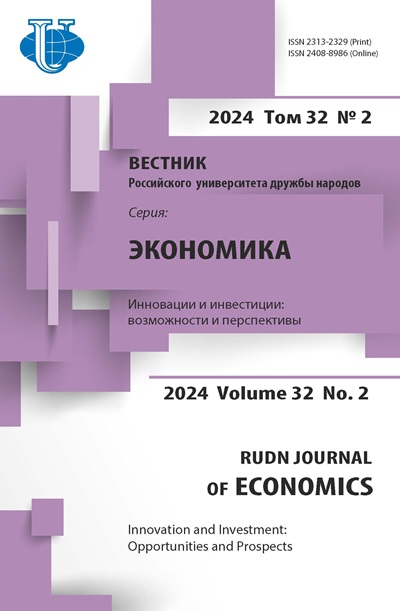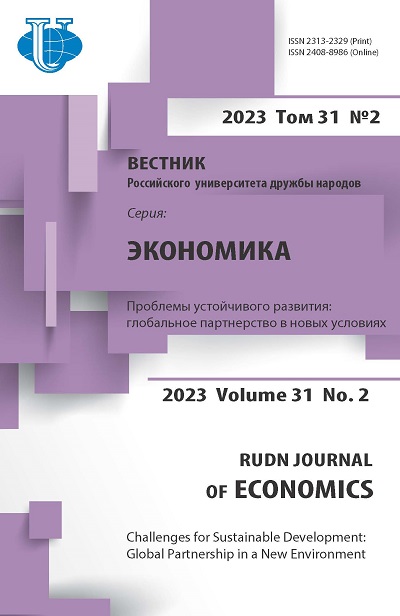Current state and prospects of development of China’s seaports
- Authors: Semenova N.K.1
-
Affiliations:
- Institute of Oriental Studies, Russian Academy of Sciences
- Issue: Vol 31, No 2 (2023): CHALLENGES FOR SUSTAINABLE DEVELOPMENT: GLOBAL PARTNERSHIP IN A NEW ENVIRONMENT
- Pages: 316-329
- Section: REGIONAL ECONOMY
- URL: https://journals.rudn.ru/economics/article/view/35283
- DOI: https://doi.org/10.22363/2313-2329-2023-31-2-316-329
- EDN: https://elibrary.ru/AFYEBL
Cite item
Full Text
Abstract
From an economic point of view, ports contribute to the comprehensive development of cities and can have a comprehensive stimulating effect on the economy of the interior. As a hub connecting various modes of transport, such as railways, highways, aviation and pipelines, ports are an indispensable component of the state’s transport network. During the gradual improvement of the Chinese transport system. At the same time, ports are the gateway for the foreign trade of a country or region. The efficiency of ports is directly related to the effectiveness of foreign economic cooperation. In addition, the development of ports is closely linked to the economic security of the country. Ports initiate the socio-economic growth of the region, serve as a center of social activity. Ports are also a major source of employment, as ports employ a large number of workers. The emergence of China as a great maritime power is becoming a fait accompli before our eyes. In the context of profound changes in the domestic and international macro environment, the port industry of the People’s Republic of China is accelerating the pace of transformation and modernization, adhering to new development concepts and providing strong support for the economic development of the state. The study reveals China’s modern leadership in the global port industry, formed in the fierce competition of the largest ports in East Asia. The stages of development of the ports of the People’s Republic of China and the role of the planned economy in this process, the modern structure of the port economy of the People’s Republic of China and the leading ports of the country are analyzed. New trends and prospects for the development of both continental and foreign ports of the People’s Republic of China are considered. The paper analyzes the place of the People’s Republic of China in the modern world port industry, determines the stages of development of China’s ports and the role of the planned economy in this process, studies the modern structure of the port economy of the People’s Republic of China and the country’s leading ports, identifies new trends and prospects for the development of mainland and foreign ports of the People’s Republic of China, analyzes key trends and problems underlying recent changes in the the port system of China. To date, there has not been a comprehensive study in the Russian bibliography that gives a general idea of the role of the port economy in the development of the PRC economy and China’s leadership in the port and shipping industries of the world. The present study aims to fill this gap.
Keywords
About the authors
Nelli K. Semenova
Institute of Oriental Studies, Russian Academy of Sciences
Author for correspondence.
Email: semenovanelli-2011@mail.ru
ORCID iD: 0000-0001-7872-8972
PhD (Political Science), Senior Researcher
12/1 Rozhdestvenka St, Building 1, Moscow, 107031, Russian FederationReferences
- Akimov, A.V. (2020). Asian maritime transport in Asia: a brief statistical essay. Eastern Analytics, 3, 15–27. https://doi.org/10.31696/2227-5568-2020-03-015-027
- Aritua, B., Cheng, L., Liere, R., & Leijer, H. (2020). Blue Routes for a New Era: Developing Inland Waterways Transportation in China (English). International Development in Focus Washington. D.C.: World Bank Group. https://doi.org/10.1596/978-1-4648-1584-3
- Bevelikova, N.M., & Petrovsky, V.E. (2021). “The Maritime Silk Road of the XXI century”: ideas and reality. China in world and regional politics. History and modernity. Vol. 26, no. 26, 151–163. (In Russ.). https://doi.org/10.24412/2618-6888-2021-26-151-163
- Brooks, M.R., Cullinane K.P.B., & Pallis, A.A. (2017). Revisiting Port Governance and Port Reform: A Multi-country Examination. Research in Transportation Business and Management, 22, 1–10. https://doi.org/10.1016/j.rtbm.2017.02.005
- Dirko, S.V., & Tikhomirova, V.S. (2020). Competitive position of the Chinese ports as infrastructure facilities of maritime transport. Transport and logistics: current issues, design solutions and innovative achievements. Materials of the All-Russian Scientific and practical Conference. Krasnoyarsk, 45–48.
- Fedorov, L.S., & Ovchinnikov, P.N. (2011). State Strategic Management for the Development of Seaports of the People’s Republic of China. Transport Massanger, (10), 16–22. (In Russ.).
- Fugazza, M., & Hoffmann, N.D.J. (2017). Liner shipping connectivity as determinant of trade. Journal of Shipping and Trade, 2(1), 1–18. https://doi.org/10.1186/s41072-017-0019-5
- Ghiasy, R., Fei Su, & Saalman, L. (2018). The 21st century Maritime Silk Road. Security implications and ways forward for the European Union. Stockholm: SIPRI. 50 p.
- Huo, W., Zhang, W., & Chen, P.S.L. (2018). Recent development of Chinese port cooperation strategies. Research in transportation business, & management, 26, 67–75. https://doi.org/10.1016/j.rtbm.2018.01.002
- Jiang, B., Li J., & Mao, X. (2012). Container Ports Multimodal Transport in China from the View of Low Carbon. Asian J. Shipping Logist, 28, 321–343. https://doi.org/10.1016/j.ajsl.2013.01.003
- Khalatyan, S.G., & Boyko, O.N. (2020). Features of the work of ports in China: logistical aspects. Science and education: topical issues, achievements and innovations. Collection of articles of the III International Scientific and Practical Conference, 76–78. (In Russ.).
- Khodova, S.S., & Vershinina, V.A. (2015). The history of the formation of free ports in China. International Journal of Applied and Basic Research, (8–3), 592–597. (In Russ.).
- Kochetova, K.V., Popova, Yu.I., & Levchenko, T.A. (2019). The state of China’s port infrastructure and its contribution to the development of the world transport infrastructure. Topical issues of modern economy, (4), 436–441.
- Komissina, I.N. (2017). The Maritime Silk Road of the XXI century — China’s global geopolitical project. Problems of National Strategy, 1(40), 60–81. (In Russ.).
- Korchagina, E.V., Topina, E.A., & Yadykin, V.K. (2020). Chinese sea ports as the key elements of foreign trade infrastructure. Digital Economy and Industry 4.0: Foresight Russia. Proceedings of the scientific and practical conference with foreign participation. Peter the Great St. Saint Petersburg: POLYTECH-PRESS. 95–99. https://doi.org/10.18720/IEP/2020.1/9
- Larin, V.L., & Pestsov, S.K. (2020). The formation of China as a great maritime power. Outlines of global transformations: politics, economics, law, 13(3), 27–46. (In Russ.). https://doi.org/10.23932/2542-0240-2020-13-3-2
- Lirn, T., Jim Wu Y., & Chen, Y.J. (2013). Green performance criteria for sustainable ports in Asia. International Journal of Physical Distribution, & Logistics, Management, 43(5/6), 427–451. https://doi.org/10.1108/IJPDLM-04-2012-0134
- Merinova, A.S. (2020). Development of Free Trade Ports in China. Polytransport systems. Materials of the XI International Scientific and Technical Conference (November 12–13, 2020), pp. 19–23. Novosibirsk: SSUPS Publishing House.
- Metelkin, P.V., & Ovchinnikov, P.N. (2014). Experience in the development of China’s seaports. Transport Massanger, 3, 42–44. (In Russ.).
- Mozias, P.M. (2013). China’s marine economy: trends and problems of development. Society and the State in China. 2013, 43(2), 424–456. (In Russ.).
- Notteboom, T., & Yang, Z. (2017). Port governance in China since 2004: Institutional layering and the growing impact of broader policies. Research in Transportation Business and Management, 22, 184–200. https://doi.org/10.1016/j.rtbm.2016.09.002
- Notteboom, T.E., & Haralambides, H.E. (2020). Port management and governance in a postCOVID-19 era: quo vadis. Maritime Economics, & Logistics, 22(3), 329–352. https://doi.org/10.1057/s41278-020-00162-7
- Semenova, N.K., & Aristova, L.B. (2020). Port of Shanghai: Factors of development. Eastern Analytics, (3), 154–178. https://doi.org/10.31696/2227-5568-2020-03-154-178
- Syachin, V.G., & Epstein, V.A. (2020). Sea port complexes as a key link in the functioning of the transport system of the People’s Republic of China. Modern Oriental Studies, 2(5), 99–113. (In Russ.).
- Yuzeev, E.A. (2018). Prospects for the development of China’s seaport infrastructure. Breakthrough economic reforms in conditions of risk and uncertainty. Collection of articles on the results of the International Scientific and Practical Conference. Tyumen, January 17, 2018, part 2, pp. 217–222. Sterlitamak: AMI. 247 p.















